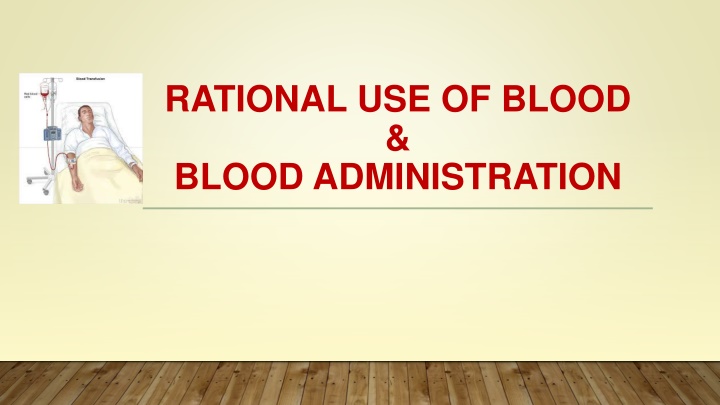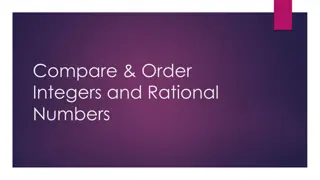Rational Use of Blood and Blood Administration
Rational use and administration of blood components are essential in modern healthcare to save lives and improve health. Blood transfusion carries potential risks and should be prescribed only for conditions with significant potential for morbidity or mortality that cannot be managed effectively by other means. The conservation of scarce resources through the separation of whole blood into components benefits more than one patient at a time.
Download Presentation

Please find below an Image/Link to download the presentation.
The content on the website is provided AS IS for your information and personal use only. It may not be sold, licensed, or shared on other websites without obtaining consent from the author.If you encounter any issues during the download, it is possible that the publisher has removed the file from their server.
You are allowed to download the files provided on this website for personal or commercial use, subject to the condition that they are used lawfully. All files are the property of their respective owners.
The content on the website is provided AS IS for your information and personal use only. It may not be sold, licensed, or shared on other websites without obtaining consent from the author.
E N D
Presentation Transcript
RATIONAL USE OF BLOOD & BLOOD ADMINISTRATION
The Appropriate Use Of Blood And Blood Products Essential part of modern health care Transfusion can save life and improve health. However, it always carries potential risks for the recipient Should be prescribed only for conditions with significant potential for morbidity or mortality that cannot be prevented or managed effectively by other means.
Why Rational use of blood? Economy -Scarcity of resource 1 in 4 get blood component Safety - Inherent risks involved in transfusion therapy 1 in 2 million gets HIV Scientifically appropriate Haematinic in nutritional anemia
1. Give only what is needed Red cells O2 carrying capacity (Anemia) Platelets Thrombocytopenia FFP Multiple clotting factor deficiency CRYO Hemophilia A
2. DIFFERENT STORAGE CONDITIONS Component Temperature Shelf Life Red Cells 2 -60 C 42 days Platelets 20-240 C 5 days Fresh Frozen Plasma -300 C 1 year Cryoprecipitates -400 C 1 year
3. CONSERVATION OF SCARCE RESOURCE Separation of whole blood in 3-4 components Benefits more than one patient at a time.
Why Whole Blood is Not Rational Better patient management concentrated dose of required component avoid circulatory overload minimize reactions eg. Requirement of platelets to raise count from 30 to 50,000/ul Fresh whole blood 5 units 1750 ml Random platelets 5 units 350-450 ml Apheresis platelets 1 unit 200-300 ml Decreased cost of management except for the cost of bag, other expenses remain same
Whole Blood Vs Packed Red Cells Parameter Whole blood Packed red cells 350 450 ml 200 240 ml Volume 1 -1.5 gm/dl 1 -1.5 gm/dl Increment in Hb Same as PRBC Same as WB Red cell mass /ml No No Viable platelets No No Labile factors ++++ + Plasma citrate ++++ + Allergic reactions ++++ + FNHTR ++++ + Risk of TTI Yes No Waste of components
Fresh Blood A Misconception What is fresh blood ? unit kept at 4oC for 4 hours is no longer fresh storage lesions in different constituents due to storage temp Increased risk of disease transmission intracellular pathogens (CMV, HTLV) survive in leukocyte in fresh blood syphilis transmission (Treponema can not survive > 96 hours in stored blood) malaria transmission (malarial parasite can not survive > 72 hrs in stored blood)
Prescribing Blood: A Checklist For Clinicians Always ask yourself the following questions before prescribing blood or blood products for a patient What improvement in the patient s clinical condition am I aiming to achieve? Can I minimize blood loss to reduce this patient s need for transfusion? Are there any other treatments I should give before making the decision to transfuse, such as intravenous replacement fluids or oxygen? What are the specific clinical or laboratory indications for transfusion for this patient? What are the risks of transmitting HIV, hepatitis, syphilis or other infectious agents through the blood products that are available for this patient? Do the benefits of transfusion outweigh the risks for this particular patient?
What other options are there if no blood is available in time? Will a trained person monitor this patient and respond immediately if any acute transfusion reactions occur? Have I recorded my decision and reasons for transfusion on the patient s chart and the blood request form? Finally, if in doubt, ask yourself the following question. If this blood was for myself or my child, would I accept the transfusion in these circumstances?
RATIONAL USE OF BLOOD Right product Right dose Right time Right reasons
CHOICE FOR ABO BLOOD GROUPS Patient type Donor PRBC Donor FFP Donor PC O Positive O O,B,A,AB O,B,A,AB A Positive A,O A,AB A,AB,O,B B Positive B,O B,AB B,AB,O,A AB Positive AB,B,A,O AB AB,B,A,O RhD Positive RhD Positive RhD Negative RhD Negative - - RhD Negative - -
Cross matching: Special Circumstances Clinical urgency Minutes Within an hour Immediate Group O RhD neg Packed RBCs ABO & RhD type ABO & RhD type Complete crossmatch Immediate spin crossmatch ( 15-20) min) Group specific blood (5-10 min) If units are issued without X match written consent of physician to be taken, -complete X match protocols followed after issue
BLOOD REQUEST FORM When blood is required for transfusion, the prescribing clinician should complete and sign a blood request form that is designed to provide all necessary information. All details requested on the blood request form must be completed accurately and legibly. The blood request form should always be accompanied by the patient s blood sample. The sample is placed in a sample tube that is correctly labelled and is uniquely identifiable with the patient. The blood sample shall not be submitted in a syringe, as this could lead to errors when transferring to a test tube for grouping and compatibility testing. It may also cause haemolysis.
For a routine case, the sample and request form should be submitted to the transfusion department at least 24 hours before required, to make sure of the availability of blood. Physicians may request those, who accompany the patient, to consider becoming blood donors if they are healthy and lead a healthy lifestyle
BLOOD SAMPLES The taking of a blood sample from the patient needs supervision. If the patient is conscious at the time of taking the sample, ask him/her to identify himself/herself by given name and all other appropriate information. A 5 mL blood sample should be collected into a dry test tube and then correctly and clearly labelled with the patient s details, and submitted to the blood centre for testing. The specimen label must include the following information: Patient s full name, age and sex. Registration number. Ward/bed number. Date and time specimen taken. Phlebotomist s signature/initials
Use positive patient identification to identify the patient. NEVER pre label the sample tube before phlebotomy. Use the blood product request form, write legibly and fill in all appropriate details. When taking a blood sample for cross match, complete the whole procedure before any other task is undertaken It is important that there are no interruptions during the process. The signature of the individual who took the sample must appear on the specimen label.
RETENTION OF BLOOD SAMPLES: Blood samples from recipient and donor(s) must be retained for 7 days at +2 C to +8 C after each transfusion. Should another transfusion be necessary 72 hours after the earlier transfusion, a fresh sample shall be requested for cross match. Collection of a second 5 mL blood sample is required for re checking and further cross matching and must be retained in case of investigation of transfusion reaction.
RED CELL COMPATIBILITY TESTING The laboratory performs: ABO and RhD grouping on patient and donors. Antibody screening on patient. Cross matching between serum of patient and red cells of donor These procedures normally take about an hour or more to complete. Shortened procedures are possible in case of emergency, but may fail to detect some incompatibilities.
COLLECTION AND RECEIPT OF BLOOD ALWAYS take a completed patient documentation label to the issue room of the blood trans fusion department when collecting the first unit of blood. MATCH the details on the blood request form against the blood compatibility label (tag), the bag unit number and the patient documentation label. If everything matches, sign out the unit with the date and time If there is any discrepancy, DO NOT sign out the unit; contact the staff member of the blood transfusion department immediately. When receiving the unit of blood in the clinical area, check that it is the right unit for the right patient.
Always check patient/component compatibility/identity. Inspect pack and contents for signs of deterioration or damage.
Blood Bag Should Be Checked For: Any sign of haemolysis in the plasma indicating that the blood has been contaminated, allowed to freeze or to warm. Any sign of haemolysis on the line between the red cells and plasma during storage. Any sign of contamination, such as a change of colour in the red cells, which often look darker/ purple/ black when contaminated. Any clot, which may mean that the blood was not mixed properly with the anticoagulant when it was collected or might also indicate bacterial contamination due to the utilization of citrate by proliferating bacteria. Any sign that there is a leak in the bag or that it has already been opened
Normal / Haemolyzed Clots
Discarding Blood The blood unit must be discarded if: It has been out of the refrigerator for longer than 30 minutes, or The seal is broken, or There is any sign of haemolysis, clotting or contamination.
Blood Transfusion Set Blood should be administered only through blood transfusion sets with filter size of 170- 200 m. Must be sterile and must never be reused. Never add medication to a unit of blood. Should not be administered with any i.v. solution containing calcium, dextrose or ringer solution.
Compatible Solutions With Blood Only Isotonic saline is recommended to be used with blood components Do Not prime the administration set with 5% Dextrose or Ringer Lactate solutions Dextrose will cause hemolysis of the red cells and calcium in Ringer Lactate will cause clot formation Before administering blood completely flush all the incompatible IV fluids and drugs or preferably Change the set
Recording of Transfusion Consent from patient and/or relatives- Valid informed consent for blood transfusion should be obtained and documented in the patient's clinical record. Pre-administration checks : STEP 1- Patient s Identification Badges, Wrist bands with Bar code labels Crosscheck the patient s identification against the compatibility report and the blood bag label. STEP-2- : Check the patient s notes for The component prescribed Any special requirements- leucodepletion, irradiation
STEP-3 Check the details on compatibility report and the blood bag labels- Blood Group Unit registration number Expiry date Type of component Any instructions for transfusion from blood bank
COLOUR CODED LABELS Blue O blood group Yellow A blood group Pink B blood group White AB blood group
IN THE WARDS/ OT PRBC Get the component issued only when the need for transfusion arises. Transfusion should be started within 30 min of issue. Transfusion should be completed in 4 hours. If any delay in transfusion is there, unit should be sent to blood bank for storage
Platelets Should never be placed in refrigerator Should be transfused as soon as possible after issue Transfusion should be completed in 20-30 min Fresh frozen plasma Should be transfused as soon as possible after issue. Transfusion should be completed in 20-30 min
Monitoring Of The Patient Before starting transfusion: Record baseline vital signs and assessment before starting each unit Temperature Blood pressure Pulse Respiratory rate Oxygen saturation if available Auscultation for patients at risk for overload (elderly, paediatric, cardiovascular disease)
After Starting Blood: For the first 15 minutes: Start initially with a slow rate (1-2ml/min or 60-120 ml/hr) unless transfusion is extremely urgent. Monitor your patient closely.
After the first 15 minutes: Reassess your patient and repeat vital signs. Increase flow to prescribed rate (2-4ml/min or 120-240 ml/hr) if no reaction observed.
Monitor the patient At least every hour during transfusion On completion of the transfusion 4 hours after completing the transfusion
Patients Blood Transfusion Notes When blood is transfused, it is important to keep detailed records including the following in the patient s notes: Type and volume of each unit transfused. Unique donation number of each unit transfused. Blood group of each unit transfused. Time at which the transfusion of each unit commenced. Signature of the individual responsible for administration of the blood.
Patients Blood Transfusion Notes Monitor the patient before, during and on completion of the transfusion. Record the time of completion of the transfusion. Identify and respond immediately to any adverse effect, by stopping the transfusion. Record the details of any transfusion reaction. Any transfusion reaction should be documented Return the transfusion form to the blood bank
WARMING BLOOD There is no evidence that warming blood is beneficial to the patient when transfusion is slow. At transfusion rates of greater than 100 mL/minute, cold blood may be a contributing factor in cardiac arrest. However, keeping the patient warm is probably more important than warming the blood.
Indications Warmed blood is most commonly required in: 1. Large volume rapid transfusions: Adults: more than 50 mL/kg/hour. Children: more than 15 mL/kg/hour. 2. Exchange transfusion in infants.























